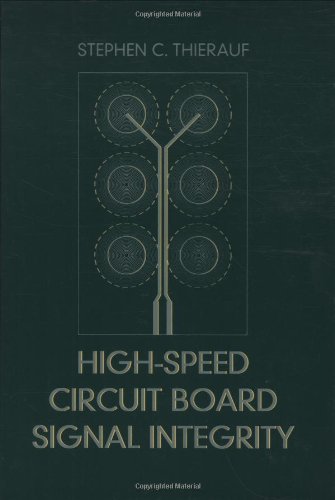Stephen C. Thierauf9781580531313, 1580531318
Table of contents :
Team DDU……Page 1
Contents……Page 8
Preface……Page 14
1.2 Unit System……Page 16
1.3 PWB Construction……Page 17
1.3.2 Alternate Resin Systems……Page 18
1.3.3 Reinforcements……Page 20
1.3.4 Variability in Building Stackups……Page 21
1.4 PWB Traces……Page 22
1.4.1 Copper Cladding……Page 23
1.4.4 Trace Etch Shape Effects……Page 24
1.5 Vias……Page 25
1.5.1 Via Aspect Ratio……Page 28
1.7 Summary……Page 29
References……Page 30
2.2 Resistance at Low Frequencies……Page 32
2.3 Loop Resistance and the Proximity Effect……Page 35
2.3.1 Resistance Matrix……Page 36
2.3.2 Proximity Effect……Page 37
2.4 Resistance Increase with Frequency: Skin Effect……Page 39
2.5 Hand Calculations of Frequency-Dependent Resistance……Page 42
2.5.2 Conductor Resistance……Page 43
2.6 Resistance Increase Due to Surface Roughness……Page 44
References……Page 45
3.2 Capacitance and Charge……Page 46
3.2.1 Dielectric Constant……Page 47
3.3 Parallel Plate Capacitor……Page 48
3.4 Self and Mutual Capacitance……Page 50
3.5 Capacitance Matrix……Page 52
3.6 Dielectric Losses……Page 54
3.6.2 Loss Tangent……Page 55
3.6.3 Calculating Loss Tangent and Conductance G……Page 56
3.7 Environmental Effects on Laminate εr and Loss Tangent……Page 58
3.7.2 Moisture Effects……Page 59
References……Page 60
4.2 Field Theory……Page 62
4.2.2 Inductance……Page 63
4.2.4 Partial Inductance……Page 64
4.2.5 Reciprocity Principal and Transverse Electromagnetic Mode……Page 65
4.3 Circuit Behavior of Inductance……Page 66
4.3.1 Inductive Voltage Drop……Page 68
4.3.2 Inductive Reactance……Page 69
4.5 Mutual Inductance……Page 70
4.5.1 Coupling Coefficient……Page 71
4.5.2 Beneficial Effects of Mutual Inductance……Page 72
4.5.3 Deleterious Effects of Mutual Inductance……Page 74
4.6.1 Inductance of a Wire Above a Return Plane……Page 75
4.6.3 Inductance of Parallel Plates……Page 76
4.6.5 Inductance of Stripline……Page 78
4.7 Summary……Page 79
References……Page 80
5.2 General Circuit Model of a Lossy Transmission Line……Page 82
5.2.2 Relationship Between ωC and G……Page 85
5.3 Impedance……Page 86
5.3.1 Calculating Impedance……Page 87
5.4 Traveling Waves……Page 88
5.4.1 Propagation Constant……Page 89
5.4.2 Phase Shift, Delay, and Wavelength……Page 90
5.4.3 Phase Constant at High Frequencies When R and G Are Small……Page 93
5.4.4 Attenuation……Page 94
5.4.5 Neper and Decibel Conversion……Page 95
5.5 Summary and Worked Examples……Page 97
References……Page 101
6.2 Proper Return Paths……Page 102
6.2.1 Return Paths of Ground-Referenced Signals……Page 104
6.3.1 When Power Plane Voltage Is the Same as Signal Voltage……Page 105
6.3.2 When Power Plane Voltage Differs from Signal Voltage……Page 108
6.3.3 Power System Inductance……Page 109
6.4.1 Motes……Page 110
6.5 Connectors and Dense Pin Fields……Page 113
6.5.2 Antipads……Page 114
6.5.3 Nonfunctional Pads……Page 117
6.5.4 Guidelines for Routing Through Dense Pin Fields……Page 118
6.6 Power Supply Bypass/Decoupling Capacitance……Page 120
6.6.1 Power Supply Integrity……Page 121
6.6.2 Distributed Power Supply Interconnect Model……Page 125
6.7.1 Via Inductance……Page 127
6.8 Summary……Page 129
References……Page 130
7.2 Harmonic Contents of a Data Stream……Page 132
7.2.1 Line Spectra……Page 134
7.2.2 Combining Harmonics to Create a Pulse……Page 135
7.2.3 The Fourier Integral……Page 137
7.2.4 Rectangular Pulses with Nonzero Rise Times……Page 138
7.3 Line Codes……Page 140
7.4 Bit Rate and Data Rate……Page 141
7.5 Block Codes Used in Serial Transmission……Page 143
7.6.1 Dispersion……Page 145
7.6.2 Lone 1-Bit Pattern……Page 146
7.7 Eye Diagrams……Page 147
7.8.1 Preemphasis……Page 149
7.8.2 Passive Equalizers……Page 152
7.8.3 Passive RC Equalizer……Page 154
7.9 DC-Blocking Capacitors……Page 155
7.9.1 Calculating the Coupling Capacitor Value……Page 157
7.10 Summary……Page 160
References……Page 161
8.2 Odd and Even Modes……Page 164
8.2.1 Circuit Description of Odd and Even Modes……Page 165
8.2.2 Coupling Coefficient……Page 168
8.2.3 Stripline and Microstrip Odd- and Even-Mode Timing……Page 170
8.2.4 Effects of Spacing on Impedance……Page 172
8.3 Multiconductor Transmission Lines……Page 173
8.3.1 Bus Segmentation for Simulation Purposes……Page 174
8.3.2 Switching Behavior of a Wide Bus……Page 175
8.3.3 Simulation Results for Loosely Coupled Lines……Page 176
8.3.4 Simulation Results for Tightly Coupled Lines……Page 177
8.3.5 Data-Dependent Timing Jitter in Multiconductor Transmission Lines……Page 179
8.4.1 Differential Signals and Noise Rejection……Page 180
8.4.2 Differential Impedance and Termination……Page 181
8.4.3 Reflection Coefficient and Return Loss……Page 185
8.4.4 PWB Layout Rules When Routing Differential Pairs……Page 187
8.5 Crosstalk……Page 188
8.5.1 Coupled-Line Circuit Model……Page 190
8.5.2 NEXT and FEXT Coupling Factors……Page 192
8.5.3 Using Kb to Predict NEXT……Page 193
8.5.5 Guard Traces……Page 194
8.5.6 Crosstalk Worked Example……Page 195
8.6 Summary……Page 197
References……Page 198
9.2 Stripline……Page 200
9.2.1 Time of Flight……Page 201
9.2.2 Impedance Relationship Between Trace Width, Thickness, and Plate Spacing……Page 202
9.2.4 Hand Calculation of Zo……Page 204
9.2.5 Stripline Fabrication……Page 206
9.3 Microstrip……Page 208
9.3.1 Exposed Microstrip……Page 209
9.3.2 Solder Mask and Embedded Microstrip……Page 211
9.4 Losses in Stripline and Microstrip……Page 212
9.4.2 Conductor Loss……Page 214
9.5.1 Broadside Coupled Stripline……Page 216
9.5.2 Edge-Coupled Stripline……Page 219
9.5.3 Edge-Coupled Microstrip……Page 220
9.6 Summary……Page 221
References……Page 222
10.2.1 Dielectric Temperature Characteristics Classification……Page 224
10.2.2 Body Size Coding……Page 226
10.2.3 Frequency Response……Page 227
10.2.4 Inductive Effects: ESL……Page 229
10.2.5 Dielectric and Conductor Losses: ESR……Page 230
10.2.6 Leakage Currents: Insulation Resistance……Page 233
10.2.7 Electrical Model……Page 234
10.2.8 MLCC Capacitor Aging……Page 235
10.2.9 Capacitance Change with DC Bias and Frequency……Page 236
10.2.10 MLCC Usage Guidelines……Page 237
10.3.1 Body Size Coding……Page 238
10.3.2 Frequency Response……Page 239
10.3.5 Effects of DC Bias, Temperature, and Relative Humidity……Page 240
10.3.6 Failure of Tantalum Capacitors……Page 241
10.3.8 Usage Guidelines……Page 242
10.4 Replacing Tantalum with High-Valued Ceramic Capacitors……Page 243
References……Page 245
Appendix: Conversion Factors……Page 246
About the Author……Page 248
Index……Page 250

Reviews
There are no reviews yet.